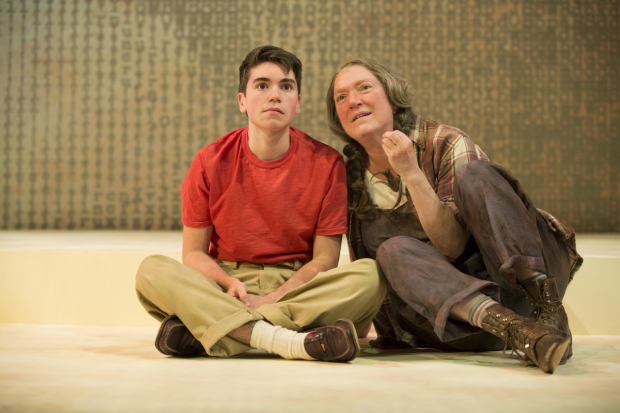What I Did Last Summer
A.R. Gurney continues his Signature residency with a homage to his childhood mentor.

(© Joan Marcus)
The romantic war-torn America of 1945 is the backdrop for A.R. Gurney's semiautobiographical story of summer love. What I Did Last Summer, the second work of Gurney's Pershing Square Signature Center residency, is set on the shores of Lake Erie where an all-American 14-year-old boy comes of age while his father is overseas. The shell of the play is an archetypal period piece, where boys will be boys and girls will ride in cars with them, despite their better instincts. Beneath that, however, is an imaginative riff on this era of cookie-cutter living, shaken by the profound platonic romance that unfolds between a boy and the teacher who shows him his own potential.
"This is a play about me when I was fourteen," says Charlie — Noah Galvin's gelled hair, high-waisted pants, and cherubic face painting an idyllic picture of 1940s American wholesomeness. Bing Crosby sings him in while opening stage directions are typed out in a projection on the back wall (a decade-appropriate design by John Narun). The world of the play is sparse, but the world of the playwright is vivid with exaggerated memories playfully brought to life via Jim Simpson's unobtrusive direction on Michael Yeargan's blank palette of a set.
The story itself is as basic as its presentation. In a nutshell, Charlie is frustrated with his molasses-paced adolescence. He yearns for a driver's license, a passing grade in Latin, and a second look from Bonny — a cute young local played by Juliet Brett with endearing teenage insecurity, particularly upon the advances of Charlie's 16-year-old Canadian pal Ted (a self-assured Pico Alexander). In the market for some "manly" work to fill his summer, Charlie lands a gig doing odd jobs for the local outcast — a quirky Boo Radley figure with Indian blood named Anna Trumbull (Kristine Nielsen), though the townies have crudely labeled her the "Pig Woman."
With wide eyes, graying braids, and a grimy pair of overalls (contrasting the rest of Claudia Brown's squeaky-clean Americana costumes), Anna very well may have a few screws loose. Still, she and her property become a kind of refuge for Charlie. His visits are an escape from his morose sister Elsie (a perfectly pouty Kate McGonigle) and mother Grace (Carolyn McCormick), who would prefer he live his life within the culturally condoned lines of 1940s America. McCormick depicts Grace as a loving, though slightly suffocating mother who constantly falls short of Donna Reed's manicured perfection. Anna, on the other hand (with whom Grace turns out to have a storied past), is a free spirit who communes with nature and lives life by the seat of her pants. She pays for Charlie's labor in art lessons, from painting to pottery to poetry, all in search of his elusive "potential" — something Charlie never even knew he possessed. Some of Anna's ultraliberal philosophies begin to seep into his vocabulary, perhaps a soundbite too many for comfort. Even so, through her voice, we can see Charlie slowly developing his own, as is the natural progression when eye-opening ideas are passed from teacher to student.
Nielsen, a Tony-nominated character actress, hits her stride in offbeat characters like Anna. Her aggressive manner is subtly threatening, and yet the energy she exudes suggests a mysterious higher plane, as if she holds the key to new, unexplored horizons. She and Galvin find a sweetness in Anna and Charlie's unorthodox bond, which, even if unhealthily codependent at times, is powerfully formative for both. Gurney uses the play to tell the story of his own childhood "Anna," adding another fascinating layer of history to the memory play and insight into its author's own creative journey. When the extraordinary product of a teacher's influence is on immediate display, that unique, indefinable relationship that shapes an artist's life gets its long-awaited due.








